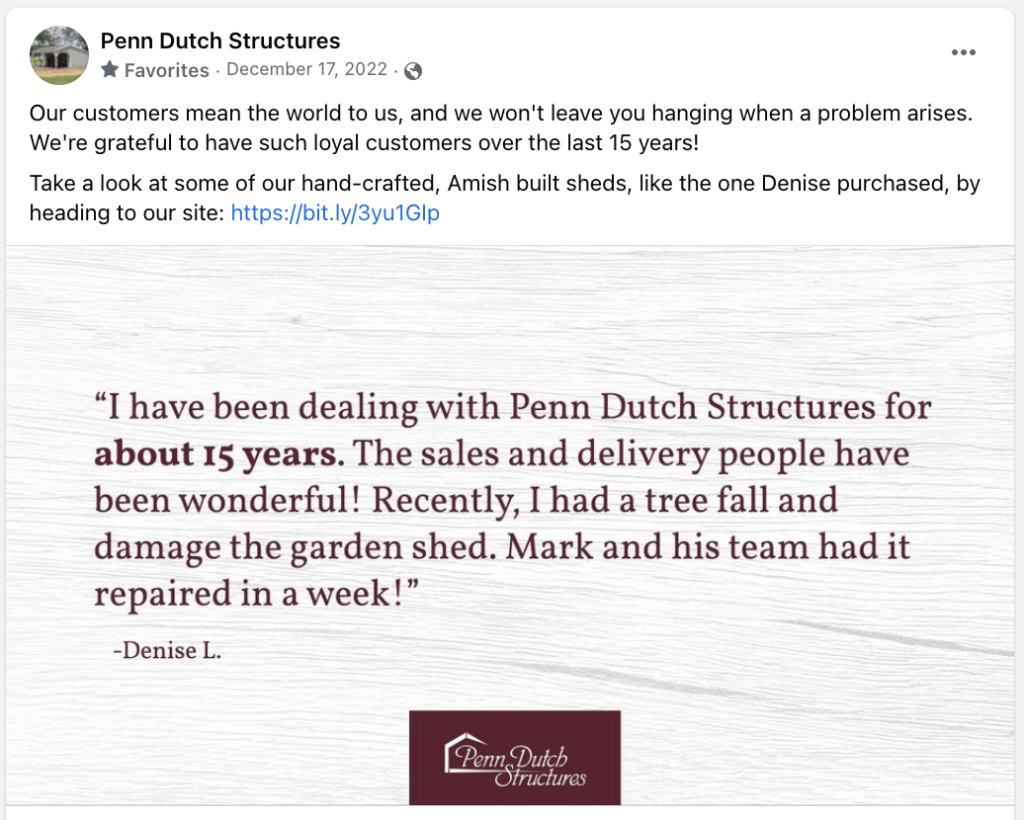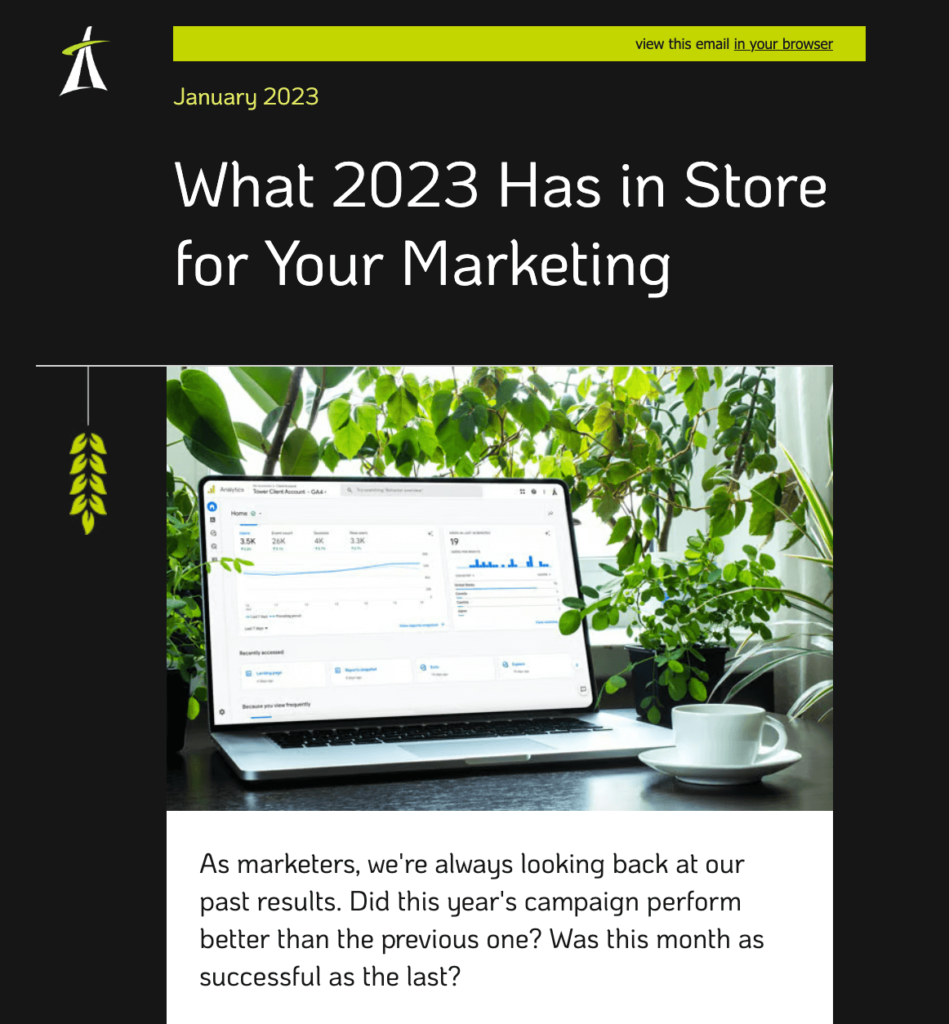Copywriting Psychology: 7 Tips & Examples You Can Use To Make Your Marketing Better
- Content Marketing
- Social Media Marketing

Being a digital content professional is way more than just being good with words. If you’re working with one, they’re not just bringing you strong writing. They’re also bringing copywriting psychology into the mix.
At Tower, our team focuses on content marketing to create pieces that support your customer’s journey. But we also step into the role of copywriting, which requires a robust set of skills that often go unnoticed when executed correctly.
Below, we’ll look at what copywriting really means. Plus, I’ll break down seven psychological principles our team has found key in helping our clients create persuasive copywriting that accomplishes their marketing goals.
Copywriting vs. Content Marketing
Simply put, the difference between the two comes down to their objectives.
Content marketing is about your strategy. What does your target audience need and what format do they want to consume it in? It’s about informing and helping your audience through different touchpoints.
Copywriting is where writing psychology comes into play. What tactics can be used in the final piece to persuade and inspire the next step? It’s about getting someone to take action.
While some argue that these are separate practices that sometimes require separate people to execute, I’d make a case that a skilled content professional should be able to switch between both.
For example, a blog should be developed strategically and shared in an appealing way to inform. (That’s the content marketing component.) But it’s also not a successful piece for your business if there’s no clear and compelling next step. (That’s the copywriting component.)
7 Copywriting Psychology Tactics & Examples
While there are plenty of discoveries we’re still making about ourselves, there are also some foundational psychological triggers we’ve established that work well in marketing. Below we’ll look at the top 7 psychological principles you should keep in mind to help make your copywriting more effective.
1. Social Proof (Informational Social Influence)
As humans, we are easily influenced by what others do. We also have the desire to make the right choice when we’re experiencing something unknown. Social proof is a psychological occurrence where a person looks to other people and follows their actions when facing an unfamiliar situation.
How Social Proof Originated
This term was penned in the ’80s by Robert Cialdini, an American psychologist, who wrote the book Influence. This book looked at six key ways humans can be persuaded, and the idea of social proof was one of those tactics.
He was inspired by lots of research examples, including a study that Stanley Milgram, Leonard Bickman, and Lawrence Berkowitz conducted in the ‘60s.
To explain it simply, they had a single person staring up at the sky and most passersby ignored him. But when they had five people staring, more people stopped and looked up. And when they had 15 people looking up, you can imagine what happened — even more folks joined in than previously.
Ways It Plays Out In Marketing
You can leverage this in your copy in a few different ways. Some marketing social proof examples in action include:
- Including influencers & endorsements.
- Incorporating customer reviews/testimonials.
- Featuring certifications from trusted organizations in your content.

2. Marketing Scarcity Principle
One way to summarize this is the idea of “FOMO” a.k.a. “fear of missing out.” We naturally want what we don’t have, and when we feel like something is limited, we elevate its value.
One warning to go along with using this tactic is to make sure you use it wisely and tactfully. Be sure that you’re not being dishonest with it, as that’s something your target audience can (and likely will) pick up on. If people sense or feel that you’re trying to manipulate them, it’ll hurt your brand equity.
How Marketing Scarcity Principle Originated
The origins of the marketing scarcity principle are a bit more nebulous. Some attribute it again to Cialdini, however, the principle of scarcity has been a long-standing theory in economics since Lionel Robbins introduced and defined it.
It’s safer to say that Cialdini saw how that economic principle could tie in with a psychological application.
Ways It Plays Out In Marketing
Some ways you’ve likely encountered this principle in copy include:
- Limited-time offers.
- Limited stock indicators/messaging.
- Low-stock banners or markers.
- Countdown timers or flash sale banners.

3. Endowment Effect & Loss Aversion
The endowment effect is the idea that we tend to overestimate the value of something we own compared to how we would value it if we didn’t own it. And around it, the ideas of loss aversion and ownership tend to feed into this psychological tendency.
As humans, we tend to prefer avoiding loss and are much more in favor of gaining something. Some studies have pointed out that we lean toward avoiding loss even in scenarios where what we gain is of equal value. (And we’re not losing value in terms of the tradeoff.)
The main takeaway from this — interjecting the endowment effect and loss aversion is a great way to motivate someone to respond to your marketing with action.
How Endowment Effect Originated
Similar to the scarcity principle, the endowment effect principle, in conjunction with loss aversion, stemmed from the study of behavioral economics and eventually was adopted in psychological studies. And while it’s been in play as long as humans have been around, it became popularized by a study performed by Daniel Kahneman, Jack Knetsch, and Richard Thaler.
Ways It Plays Out In Marketing
This tactic can hold weight in how you approach copywriting. To leverage it:
- Use “negative” framing and help your audience consider what they lose from not taking action. (As opposed to the “positive” of what they gain.)
- Give your audience ownership in what they’re getting, either through customization or the steps they take to acquire what you’re offering.
- Consider specific phrasing like “don’t miss” or “free” to trigger your audience.

4. Storytelling
In this age where binge-watching is a pastime we’ve all likely enjoyed, it’s no secret that people like stories. But the reason is much deeper than just their entertainment value. Stories are a framework that helps us connect and relate to other people or concepts, especially when we’re encountering something new.
An interesting NPR article on storytelling summarizes the science to show that the act of listening or reading a story involves a lot more of our brain than processing straight data or statistics. (It elicits the process of mirroring, putting us in sync with the storyteller.) Even reading a story increases brain activity in the areas we use for deciphering and imagining.
Plus, stories are more memorable and we’re more likely to repeat them. This means they can better reinforce a new idea and even change our perspectives and attitudes.
How Storytelling Originated
Stories are as old as we are, but one of the first recorded stories that are recognized by historians is The Epic of Gilgamesh and Homer’s The Iliad. Over time inventions like written languages, the printing press, motion pictures, and the internet have diversified how we tell stories and also made them easier to share.
Ways It Plays Out In Marketing
There’s absolutely a time and a place for listing out benefits. But if you can weave them into a story, there’s a chance it will help your marketing message stick better and persuade. Whether you’re working on B2B or B2C copy try:
- Telling stories and weaving narratives in landing page copy.
- Using video anecdotes.
- Encouraging user-submitted stories on social media.
- Using customer testimonials to tell a story.
Pro tip: to make your story even stronger try having it follow a clear arch or using the Zeigarnik Effect.
5. Autonomy Bias
At the heart of our actions, humans have a natural desire to want to be in charge of making our own choices freely. We like having a sense of power and control over our future. So this bias can look like us exercising our will over how, why, where, or what we do.
When you can pivot your copywriting to speak to this and even give your audience a sense of control in how they interact with it, the better.
How Autonomy Bias Originated
While it’s a principle as old as time, this term itself became popularized in psychology when Richard Ryan and Edward Deci developed the self-determination theory of motivation. Their work in psychology showed that reinforcing actions with rewards wasn’t the only way to motivate people. Their research was highly esteemed as a big development in psychology at the time as it brought these new and different theories to the table.
Ways It Plays Out In Marketing
In looking at how to use this tactic in copywriting, here are some suggestions to start:
- Speak directly to your audience and frame the message of them being in control.
- Use self-guided interactive elements.
- Create a self-stepped form.

6. Information Gap Theory
Simply explained, the information gap theory is the idea that if someone is uncertain they will put in work between what they know and what they need to learn to make a decision. Gathering relevant information is a tactic people use and rely on when they don’t have the experience to go off of.
How information Gap Theory Originated
This principle itself seems to have first shown up in the scientific community during the ‘60s, but it peaked in popularity in the ‘90s. Perhaps that spike can be attributed to George Loewenstein of Carnegie Mellon since he popularized the term itself in the studies he presented in the mid-‘90s.
Ways It Plays Out In Marketing
A few ways to leverage this natural tendency for curiosity include:
- Using provoking questions in headlines and placing the answer in the body content that follows.
- Incorporate it in the meta descriptions for landing pages leading to your site from search.
- Craft it into your email subject lines and preheader text.

7. Temporal Landmarks & Temporal Discounting
To put it simply, temporal landmarks are frameworks we mark time between our old self and future self. These are moments that stand out to us in time such as the start of the week, a new day, the new year, birthdays, and anniversaries, to name a few examples.
We use these to inspire ourselves to plan and begin taking specific steps, such as goal setting in the new year or starting a new diet at the start of the week. We’re more likely to do these things in certain times we associate as a meaningful break between the past and future, than choosing a random day to start.
On the flip side, temporal discounting gets at the idea that we’d rather have the gratification of something now instead of waiting, even if waiting ends with us getting slightly more. For example, taking a $100 check today instead of waiting six months for a $150 check. This all shows our relationship with time can be quite complicated.
How Temporal Landmark Theory Originated
Inspired by the work of psychologist Theodule Ribot, Nucgaek Shum wrote a popular paper in the late ‘80s on “The Role of Temporal Landmarks in Autobiographical Memory Processes.” As for where temporal discounting comes into play, it’s not clear exactly who first coined the term, but it initially came out of behavioral economic studies.
Ways It Plays Out In Marketing
A few ways you can find inspiration to use temporal landmarks and discounting in your marketing include:
- Crafting email campaigns around landmarks your audience would value and use.
- Creating page elements and CTAs that play into temporal discounting urges.
- Schedule social posts and ad campaigns around those important landmarks.

Need more help crafting the right messaging? Get support from an experienced content marketing team who can help you frame your message with the right copywriting psychology tactics.
 By Grace H
By Grace H  Alex S
Alex S